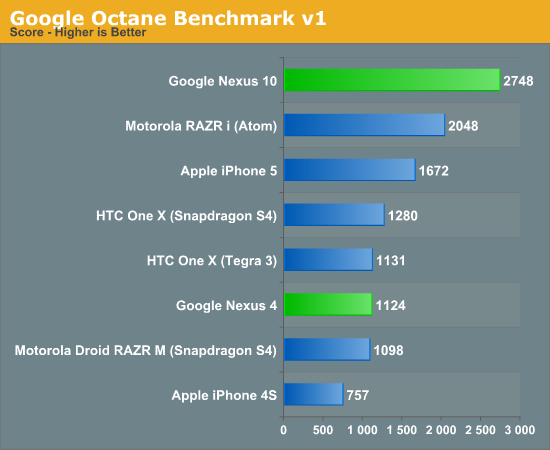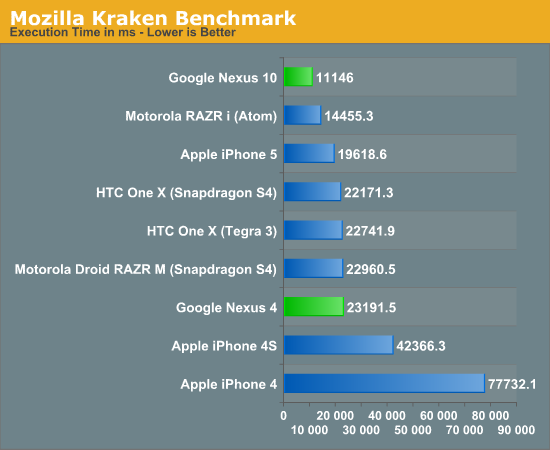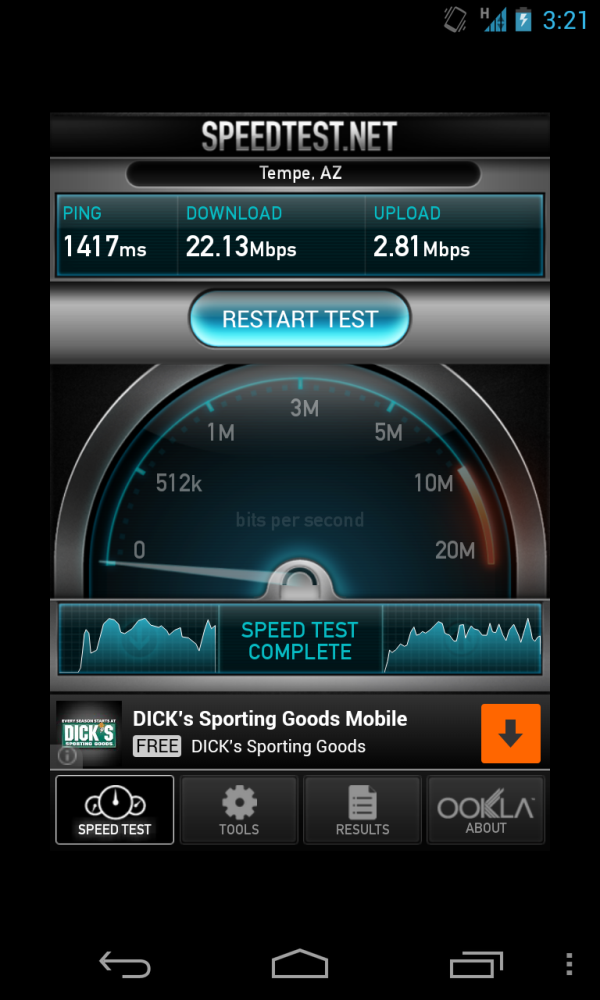Google Nexus 4 and Nexus 10 Performance Preview
by Anand Lal Shimpi & Brian Klug on November 2, 2012 11:00 AM ESTEarlier this week Google announced two new flagship Nexus devices: the Nexus 4 smartphone and the Nexus 10 tablet. We received review samples of both earlier this week, and while we're hard at work at full reviews of the devices we couldn't help but share all of the test data we've been able to amass at this point.
For those who aren't familiar with it, the Nexus 4 features Qualcomm's Snapdragon S4 Pro SoC - a quad-core 28nm Krait CPU with Qualcomm's next-generation Adreno 320 GPU. The combination proved quite formidable in the MDP/T we tested, as well as LG's recently announced Optimus G. The SoC drives a 4.7-inch 1280 x 768 IPS display and is paired with 2GB of LPDDR2 memory. The Nexus 4 ships unlocked with 8GB of NAND for $299 without a contract ($349 for the 16GB version). Pair that with DC-HSPA+ support and you get an absolute killer smartphone for use on T-Mobile: no contracts, very low monthly fees, and compelling cellular performance:
Brian will talk more about the combination in his full review, but rest assured that the lack of LTE is workable depending on T-Mobile coverage where you live/travel to.
The Nexus 10 also boasts a brand new SoC: Samsung's Exynos 5 Dual. The Exynos 5 Dual features two ARM Cortex A15 cores running at 1.7GHz as well as ARM's own Mali-T604 GPU. This happens to be the exact same platform used in the new Chromebook, just running Android. The Nexus 10 features a 10.1-inch 2560 x 1600 display, giving it the same resolution as the 13-inch MacBook Pro with Retina Display - but in an even smaller form factor. Google is also aggressive on Nexus 10 pricing: the 16GB WiFi-only tablet sells for $399, with the 32GB version going for $499.
Both Nexus devices run Android 4.2 and are guaranteed to be the first devices to be updated to upcoming Android revisions for the foreseeable future (it's the power of Nexus).
We haven't had a ton of time to test the devices and put this together so you're going to see combined performance charts throughout the rest of this article.
CPU Performance
The big story when it comes to CPU performance is a look at how the Cortex A15s perform under Android. Unfortunately we're still left with mostly browser based benchmarks to measure CPU performance, which actually highlights a major issue in our testing: Android V8 optimization doesn't seem to be anywhere near as good as it is under Chrome OS or Windows. As a result, all of the Nexus 10 performance scores end up slower than the new Chromebook - despite using the same SoC and running Chrome on both platforms. It's also possible that the Exynos 5 Dual in the Chromebook is allowed to burn a bit more power, translating to better performance, but either way the solution here in the Nexus 10 doesn't look as good across the board.

SunSpider performance is good, but not significantly better than Qualcomm's Krait based Snapdragon S4. Both the iPhone 5 and RAZR i are able to outperform the Nexus 10. The S4 Pro based Nexus 4 tends to be in line with other S4 based devices - SunSpider doesn't really give much credit to the extra 2 cores.

BrowserMark puts the Nexus 10 behind many platforms that should be faster, I'm even wondering here if there's some hard partitioning of memory bandwidth between the CPU and GPU to drive the 2560 x 1600 display that's simply choking the CPU here.
The Nexus 4 does ok, but again there seem to be some V8 optimization issues at work here under Android 4.2. At 1.5GHz it should deliver at least the performance of the dual-core Snapdragon S4 solutions.

Octane is the first test where the Cortex A15s are really able to flex their muscle - the Exynos 5 Dual based Nexus 10 manages to outperform the RAZR i by 34%, and compared to the A6/Swift based iPhone 5 the advantage grows to 64%.
The Nexus 4 performs about in line with other Snapdragon S4 based devices, although once again the extra 2 cores don't seem to be doing much for it here at all.

Kraken also paints the Cortex A15 based Nexus 10 in a good light: there's a 30% advantage over the RAZR i and a 76% advantage over the iPhone 5. These numbers will shrink a bit compared to other tablets, but not by much. The Nexus 4, once again, ends up performing similarly to dual-core Snapdragon S4 based devices.
Overall, the Nexus 10 results show us some real promise for what we can expect from ARM Cortex A15 based SoCs. The potential upside to this new architecture is huge.

















244 Comments
View All Comments
Chloiber - Friday, November 2, 2012 - link
I'm extremely disappointed with the performance of the Nexus 4.You compare it (that's not meant as critique, as it's not officially available yet in most countires) with ICS devices. The performance increase with 4.1.1./4.1.2 is huge. The One X (Tegra 3) for example, scores a bit over 1000ms in SunSpider and 7000 in Quadrant.
The Nexus 4 however, despite having 4.2 on board is behind nearly everything else with comparable processors. I really hope it's just a 4.2 issue that will be fixed soon!
r3loaded - Friday, November 2, 2012 - link
Something certainly is iffy with the results as the mostly identical Optimus G seems to be beating the Nexus 4 by significant margins. I'm guessing a lot has to do with the benchmarking software not being updated for 4.2.Also, I wouldn't put any faith in the browser tests - he's using the stock browser for Android phones which isn't as quick as Chrome for Android.
nyarlathotep2 - Friday, November 2, 2012 - link
I don't know about Chrome being faster than the stock browser. On my devices, the stock android browser pretty much demolishes Chrome on the benchmarks, and I actually prefer the way it renders (I love Chrome on my PC's).But, oddly enough, my old Tegra 2 device browser-benchmarks considerably better than what I've seen listed for many newer (and certainly faster in other benchmark) devices.
TF101, running JB 4.1.2, slightly overclocked at 1200:
Stock Android Browser/Chrome
Sunspider: 1280 ms/1630ms
Kraken: 22,300 ms/24,828 ms
Browsermark: 161,925/123,350
Octane: 1527/1389
I find it odd that these scores from a tired old device are generally better than what I have seen listed for newer/faster devices, often with more cores.
Chloiber - Friday, November 2, 2012 - link
As I said: Jellybean! Huge improvements were made there. A HTC One X with Jellybean scores under a little bit over 1000ms in SunSpider. So just imagine how those scores would look like if the other phones got updated to JB. The Nexus 4 would be WAY behind, even though it has NEWER software.Also, the battery life is extremely weak. Compare it to the One X (granted that it has that companion core). Quadcore 40nm vs. Quadcore 28nm. 1600mAH vs. 2100mAH. The One X lasts way longer.
c4v3man - Friday, November 2, 2012 - link
Comparing a Verizon LTE phone against and AT&T LTE phone will yield different results, especially if there are significant coverage differences. For example, HTC One X AT&T vs Galaxy S3 Verizon on your chart. They both use the same radio platform basically, but obviously they have other factors such as the screen (SAMOLED takes more power than the One X's LCD) etc. However, when seeing the iPhone's numbers, we have no idea what carrier you're testing with.dstephens80 - Friday, November 2, 2012 - link
the extremely high latency shown in the speedtest screenshot? I sincerely hope that 1417ms ping times are a fluke and not the norm. who cares if you have 22Mb d/l speed when it takes 1.4s between packets.nidz1 - Friday, November 2, 2012 - link
That ping time is not accurate. I frequently see a high ping when starting a Speedtest, but if I ping the ip of the test server in terminal emulator I'll see 60-85ms, which is definitely normal. I think it has to do with the radio coming out of power save. Try it for yourself. I'm using T-Mobile, btw.Krysto - Friday, November 2, 2012 - link
It seems Google hasn't changed the V8 engine in Chrome for Android pretty much since they officially launched it. Not to mention Chrome for Android just got upgraded to version 18, when we're supposed to get version 23 in a week or two on the desktop. Incredible. The Chrome browser is close to a year behind in Javascript improvements compared to Apple and its Safari for iOS which probably got upgraded just before launching iOS6.It's very disappointing to see the very same chip score twice as slow in Chrome, because Google can't be bothered to treat it as seriously as they do on the desktop.
AnotherHariSeldon - Friday, November 2, 2012 - link
I don't see how Google (or Samsung etc) can compete with Apple gen for gen until they switch to using Imagination's SGX as opposed to ARM's Mali. Particularly given the next gen "Rogue" architecture that will further widen the performance gap with an order of magnitude increase in performance.http://www.anandtech.com/show/5364/powervr-series-...
meloz - Friday, November 2, 2012 - link
>I don't see how Google (or Samsung etc) can compete with Apple gen for gen until they switch to using Imagination's SGX as opposed to ARM's Mali.I can actually see them giving up on ARM altogether and going with new generation Intel Atoms from 2014 on.